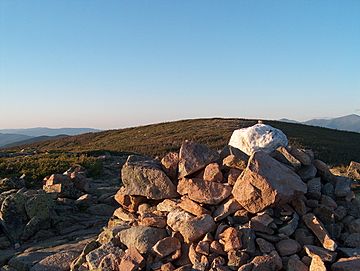Mount Guyot (New Hampshire) facts for kids
Quick facts for kids Mount Guyot |
|
|---|---|

Mount Guyot at sunset
|
|
| Highest point | |
| Elevation | 4560+ ft (1390+ m) NGVD 29 |
| Prominence | 160 ft (49 m) |
| Geography | |
| Location | Grafton County, New Hampshire, U.S. |
| Parent range | Twin Range |
| Topo map | USGS South Twin Mountain |
Mount Guyot is a mountain found in Grafton County, New Hampshire. It is named after Professor Arnold H. Guyot (1807–1884) from Princeton University. This mountain is part of the Twin Range, which is a section of the famous White Mountains.
Mount Guyot has other mountains nearby. To its northwest is South Twin Mountain. Mount Zealand is to its northeast, and Mount Bond is to its south. Guyot is also on the northern edge of a special wild area called the Pemigewasset Wilderness. Near the top of Mount Guyot, you'll see short, twisted trees known as krummholz. These trees grow in tough, windy conditions.
Water Flowing from Mount Guyot
Water from the north side of Mount Guyot flows into the Little River. This river then joins the Ammonoosuc and Connecticut rivers. Eventually, this water reaches Long Island Sound in Connecticut.
The southeast side of Guyot drains into Jumping Brook. This brook flows into the North Fork of the East Branch of the Pemigewasset River. From there, the water goes into the Merrimack River and finally into the Gulf of Maine in Massachusetts. The southwest side of Guyot sends its water into the Franconia Branch of the East Branch of the Pemigewasset River.
The Appalachian Trail
The famous Appalachian Trail crosses the summit of Mount Guyot. This trail is a very long path, stretching about 2,170 miles (3,500 km). It goes all the way from Georgia to Maine. The trail follows the ridges from South Twin Mountain to Mount Zealand, passing right over Mount Guyot.
Even though Mount Guyot is over 4,000 feet (1,200 meters) tall, the Appalachian Mountain Club (AMC) doesn't count it as a "four-thousand footer". This is because it doesn't rise very high above the land connecting it to South Twin Mountain. To be a "four-thousand footer" in New Hampshire, a mountain needs to rise at least 200 feet (61 meters) above the lowest point between it and any higher peak. Mount Guyot doesn't meet this specific rule.

